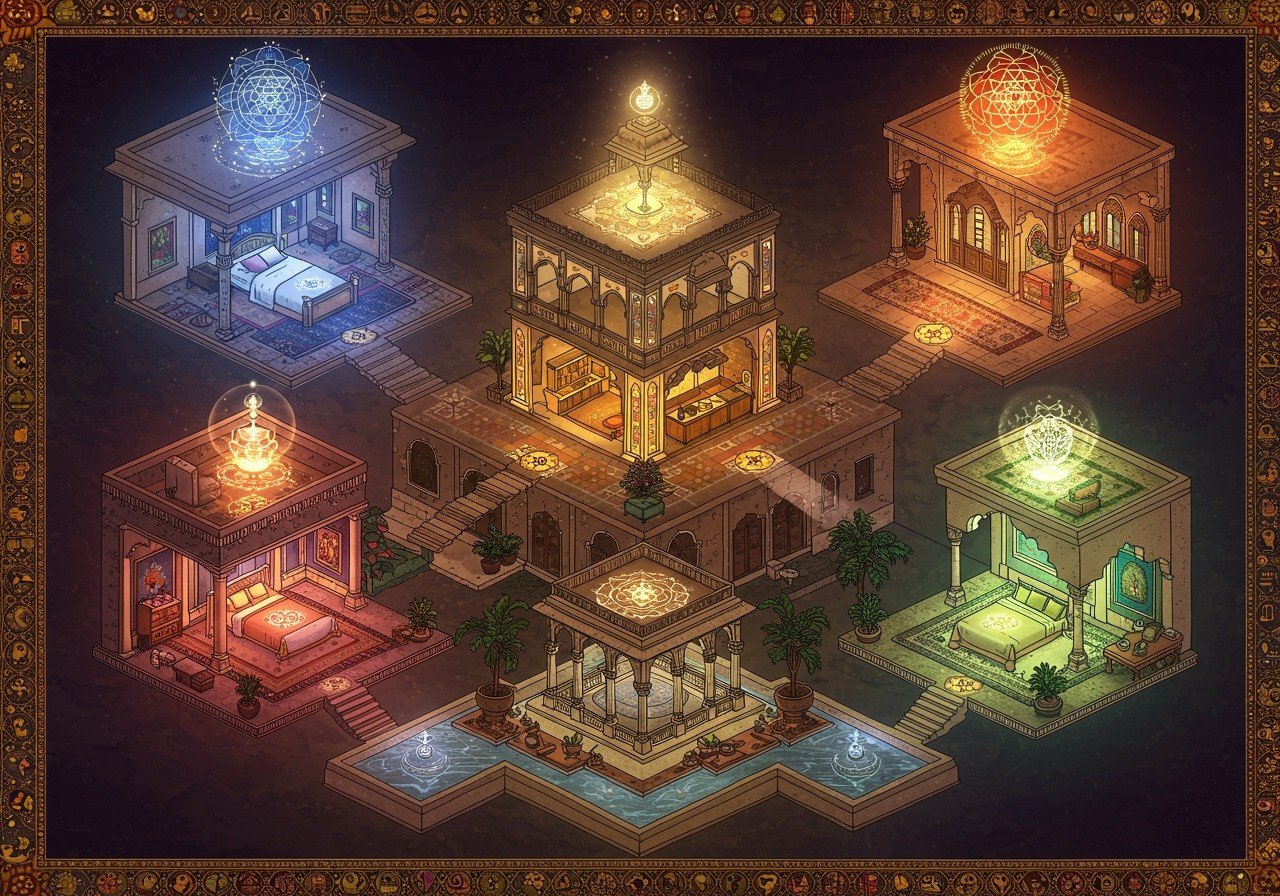
Vastu Shastra, the ancient Indian science of architecture, helps us design homes filled with balance and positive energy. It guides us in creating spaces that enhance peace, prosperity, and overall well-being. This article offers a detailed room-by-room guide, blending traditional wisdom with modern living, to help you optimize your home for 2025.
Vastu for the Bedroom: A Sanctuary of Rest
The bedroom, your personal haven for rest and rejuvenation, should be aligned with Vastu principles for enhanced well-being. The southwest corner is considered the most suitable location for the master bedroom, symbolizing stability and groundedness. Positioning your bed with the head pointing south is believed to promote sound sleep and good health. Avoid placing mirrors directly facing the bed, as they can disrupt peaceful sleep. Opt for calming, pastel colors to create a relaxing atmosphere. A clutter-free bedroom allows positive energy to flow freely. Minimizing electronic gadgets in the bedroom reduces distractions and promotes better rest. Natural materials like wood for furniture add to the tranquil ambiance.
Vastu for the Kitchen: The Heart of the Home
The kitchen, the heart of your home and a space associated with the fire element, requires careful Vastu planning. Ideally, the kitchen should be located in the southeast corner of your home. Placing the stove in this direction is believed to balance energies and promote health. Facing east while cooking is thought to bring positivity and nourishment. It is also recommended to keep water elements (like sinks) separate from fire elements (like the stove) to maintain balance. Bright, cheerful colors like yellow or orange can boost appetite and energy. A clean and organized kitchen naturally promotes health and well-being. Ample natural light and proper ventilation are essential for a healthy and vibrant kitchen environment.
Vastu for the Pooja Room: A Sacred Space
The pooja room, a sacred space in every Indian home, deserves special attention in Vastu Shastra. The northeast corner, also known as the Ishan Kona, is the ideal location for your pooja room, fostering spiritual growth and connection. Placing deity idols facing east or west is believed to enhance the effectiveness of prayers. Maintaining a clutter-free pooja room and using it solely for worship helps preserve its sanctity. Light colors like white or light yellow create a serene and spiritual atmosphere. Using natural materials like wood or marble for the pooja room adds to the purity of the space. Fresh flowers and the gentle fragrance of incense can further invite positive energy. Regular cleaning of the pooja room is essential to sustain its spiritual vibrations.
Looking for authentic pooja essentials? Poojn.in offers a wide selection of Ashtagandha Kumkum and other traditional items to enhance your spiritual practices.
Vastu for the Entrance: Welcoming Positive Energy
The entrance of your home is the gateway for positive energy. Positioning it in the northeast, north, or east direction is believed to invite prosperity and good fortune. A clean, well-lit, and clutter-free entrance is crucial. Decorating the entrance with auspicious items like rangoli or torans is a traditional way to welcome blessings into your home. Avoid placing shoes or dustbins near the entrance, as they can obstruct the flow of positive energy. A beautiful, vibrant plant at the entrance adds a touch of freshness and positive vibrations.
Vastu for the Living Room: Harmony and Togetherness
The living room, a space where family and friends gather, should be designed to promote harmony and togetherness. Locating the living room in the north, east, or northeast part of the house is believed to maximize positivity. Arrange the seating in a comfortable and inviting manner that encourages conversation and connection. Adding indoor plants, such as lucky bamboo or money plants, brings a touch of nature and positive energy into the living room. Positioning sofas and cabinets along the west or south walls provides a sense of stability and support. Keeping the northeast corner of the living room clean and uncluttered allows energy to flow freely.
Vastu for the Center of the Home (Brahmasthan): The Core of Balance
The Brahmasthan, the center of your home, is considered sacred and should be kept open and clutter-free. This ensures smooth circulation of energy throughout the house. Avoid placing heavy furniture or objects in this central zone. Maintaining a light and airy Brahmasthan encourages balance and peace in your home. A brass tortoise with a plate can be a beautiful and auspicious addition to this central space.
Vastu for the Northeast: Clarity and Wisdom
The northeast zone of your home is associated with clarity, wisdom, and spiritual growth. It’s an ideal space for meditation, prayer, or quiet reflection. Placing a serene painting or a meditating Buddha statue in this area can enhance focus and inspiration. Avoid placing heavy furniture or storage in the northeast to maintain its purity and allow energy to flow freely.
Vastu for the Southwest: Strengthening Relationships
The southwest corner of your home is believed to influence relationships and family bonds. Using soft, earthy tones in this area creates a nurturing and supportive atmosphere. Decorate with symbols of love and togetherness, such as a pair of swans or a family portrait, to foster harmony and strengthen relationships.
Things to Avoid in Vastu: Maintaining Harmony
- Blocking the Northeast: Never clutter the northeast zone, as this can disrupt mental clarity and spiritual growth. Ensure this area remains open and free-flowing for positive energy.
- Incorrect Bedroom Placement: Avoid placing the bedroom in the northeast, as it can hinder restful sleep and create restlessness. The southwest is the ideal location for the master bedroom.
- Northern Kitchen Placement: Avoid placing the kitchen in the north. The southeast is the preferred location for the kitchen, balancing the fire element and promoting health.
- Heavy Objects in the Center: Keep the Brahmasthan, the center of your home, free from heavy furniture or objects. This allows for the smooth circulation of energy throughout the house.
- Mirror Placement: Avoid placing mirrors directly opposite the bed or the main entrance, as they can reflect and disrupt the flow of positive energy.
- Dark Colors in the Bedroom: Avoid using dark colors in the bedroom, as they can create a heavy and restless atmosphere. Opt for calming, pastel shades to promote relaxation and peaceful sleep.
- Storage Under the Stairs: Avoid storing shoes, cleaning materials, or unused items under the stairs. Clutter in this area can block the flow of positive energy.
Enhance the purity of your pooja rituals with pure brass Doob grass from Poojn.in. It’s a beautiful and traditional way to honor the divine.
Embracing Vastu in Modern Life
Integrating Vastu Shastra into your home design brings balance, harmony, and positive energy into your life. By aligning each room with Vastu principles, you create a space that supports your well-being and fosters happiness. Remember to maintain clean, clutter-free spaces, incorporating natural elements like plants to enhance positive vibrations. With these simple yet powerful guidelines, you can honor traditions while enjoying the comforts of modern living, creating a harmonious home for you and your family in 2025 and beyond.
Frequently Asked Questions about Vastu Shastra
How does Vastu Shastra apply to the bedroom? Vastu principles guide the optimal placement of furniture and the use of colors in the bedroom to promote restful sleep and a peaceful ambiance. Positioning the bed against the south or west wall is often recommended for better sleep quality.
How does Vastu influence kitchen design? Vastu suggests locating the kitchen in the southeast, aligning with the fire element. The stove’s placement and the direction you face while cooking are also key considerations.
Why is the northeast corner ideal for a pooja room? The northeast, or Ishan Kona, is considered highly auspicious, making it the perfect location to invite positive energies and blessings into your home through prayer and worship.
Can Vastu be applied to small apartments? Yes, Vastu principles can be adapted to any living space, regardless of size. Even in small apartments, thoughtful placement of furniture and mindful use of colors can improve energy flow.
Do I need to follow Vastu for every room? While not mandatory, applying Vastu principles to each room can significantly enhance the overall harmony and balance of your living space.
What should I avoid in the bedroom according to Vastu? Avoid placing mirrors facing the bed, as they are believed to disrupt sleep. Clutter under the bed should also be avoided to maintain a peaceful atmosphere. Poojn.in offers a range of decorative items that align with Vastu principles to enhance the positive energy in your bedroom.
How does Vastu impact family relationships? Vastu can positively influence family dynamics by promoting comfort, harmony, and open communication within the home. Proper room and furniture placement can enhance understanding and reduce conflicts.
Poojn.in: Your Partner in Creating a Vastu-Compliant Home
At Poojn.in, we understand the importance of creating a home that resonates with positive energy and reflects your cultural values. We offer a wide variety of products and solutions to help you align your living spaces with Vastu principles. Explore our collections:
- Pooja Samagri: Everything you need for your daily rituals and special ceremonies.
- Holy Utensils: Authentic and beautifully crafted utensils for your pooja room.
- Sacred Idols: Divine idols of various deities in a range of materials and sizes.
- Pooja Kits: Convenient kits for specific pujas and festivals, containing all the essential items.
For personalized guidance on selecting the right Vastu-compliant items for your home, our product specialists are available to assist you. You can reach us at:
- Phone: 03369029784
- WhatsApp: 9476142738
Visit www.poojn.in today and discover a world of sacred items to enhance your spiritual journey and create a harmonious home.


